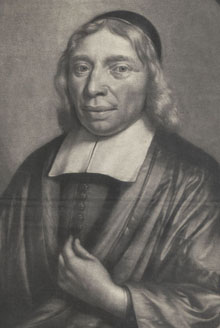Protestant portraits > The portraits
Technique
The portraits have been created as drawings, copper engravings, etches, mezzotints, aquatints, lithographs, photos, etc. A small part consists of cuttings from illustrated magazines. The oldest portraits date back to the beginning of the 16th century, the newest date from the end of the 19th century.
The learned pastor
The prints often show the pastor as a learned man, who sometimes makes an expressive gesture or holds his hand to his heart as a sign of his love of God. And they particularly show him in the company of books, very many books. This would seem to speak for itself but this image should be looked at with some caution.
The image depicted on the print is not just any ‘snap' of something that looked like this at a certain point in time. The artist, responsible for making such portraits, usually kept to certain prevailing views on how such works of art ought to be made.
The Mennonite pastor Tobias Govertsz van den Wyngaert had his portrait made in 1666, at the age of 80, in front a well-filled bookcase, half covered by drapes. However, the estate of this pastor showed that he possessed merely a handful of books!
Garments
It is often thought that pastors have always worn a robe. We do, in fact, see on prints that pastors wore this respectable, distinguished garment from the middle of the 19th century.
Prior to this, the pastor wore a black suit with a cloak and - since the second half of the 17th century - a white jabot. Some theologians wore robes and wide, white jabots to show they were professors.
With regard to hairstyle: this varied from long to short, with or without beard, curls and from the end of the 17th century a wig. It was sometimes claimed that the shape of the wig revealed the theological conviction of the pastor.

